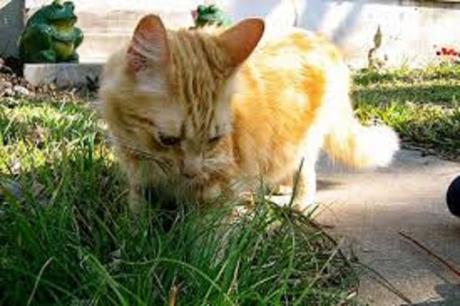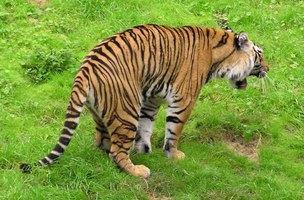“Look at the birds of the air; they do not sow or reap or store away in barns, and yet your heavenly Father feeds them. Are you not much more valuable than they?” -Matthew 6:26
If you’ve ever had a cat or a dog, you would have seen your pet eat grass and then throw up.
That’s your cat/dog’s way to self-medicate.

Even the big cats, like tigers and lions, do it!
Here’s a pic of a tiger vomiting after eating grass:

The Daily Mail reports that the theory of self-medicating animals is called zoopharmacognosy, from the root words zoo (‘animal’), pharma (‘drug’), and gnosy (‘knowing’).
According to Joel Shurkin, writing in the journal Proceedings of the National Academy of Sciences of the United States of America (PNAS):
“A wide range of animals self-prescribe the plants around them when they need a remedy…. It’s not clear how much knowing or learning is involved, but many animals seem to have evolved an innate ability to detect the therapeutic constituents in plants. Although the evidence is entirely circumstantial, the examples are plentiful. The practice is spreading across the animal kingdom in sometimes surprising ways.”
For example, despite the fact eating grass makes them sick, domestic and wild dogs and cats around the world actively seek out the plant, a way for the animals to relieve a stomach ache and get rid of anything in their gut that is causing discomfort.
Vancouver-based vet Dr. Michael Goldberg explains: “Dogs do not have the means to digest grass, as they lack the enzymes needed to break down the fibers. Thus, there is little nutritional value in it for them. One reason for eating grass may be due to a feeling of nausea. It is possible that dogs learn this is a temporary solution for stomach irritation.” Tests on dogs that have exhibited these behaviors have later revealed inflammatory conditions in their stomachs, as well as signs of gastric reflux or bowel disease.
Other known self-medicating animals include:
- Chimpanzees have been spotted swallowing the leaves of up to 35 Aspilia plants whole, in a behavior thought to treat parasites.
- The leaves contain a chemical known as thiarubrine-A, which kills certain intestinal parasites, while the roughness of certain plants can act like ‘sandpaper’ to remove the parasites.
- Red and green macaws have been known to eat kaolin clay to help with digestion problems. This is said to be a “detoxifying” to rid themselves of toxic berries and seeds. Conservation zoologist Charles Munn believes that many macaws will lick clay on riverbeds to obtain minerals and to counter the bitter tannin and alkaloid compounds found in many of these seeds.
- Tapirs, forest elephants and mountain gorillas. also ingest clay to absorb bacteria and alleviate diarrhea.
- Pregnant elephants in Kenya have been observed eating the plant boraginaceae, which is not part of their regular diet. A few days later, the elephant gave birth. Boraginaceae is also used by women in Kenya to induce labor.
- Pregnant lemurs have been spotted eating tamarind and bark to boost milk production and increase the chances of a successful birth. They also feed the bark to their offspring to help kill parasites.
- Mountain goats in Northern Italy lick the stones for their salts and minerals, a behavior that’s also seen in macaws, as a supplement when food supplies are low, or they are unwell.
- Some lizards are believed to respond to a bite by a venomous snake by eating a certain root to counter the venom.
- Baboons in Ethiopia eat the leaves of a plant to combat the flatworms that cause schistosomiasis.
- Fruit flies lay eggs in plants containing high ethanol levels when they detect parasitoid wasps, a way of protecting their offspring.
- Some animals apply remedies topically:
- More than 200 species of birds, for example, grasp ants in their bills and wipe them across their feathers — a behavior called “anting.” Ants that spray formic acid can kill off feather lice and protect the birds from infection.
- Female capuchins have been known to rub sugary syrups on wounds.
- North American brown bears treat insect bites using a paste of their saliva and Osha roots that contain compounds that repel insects.
In fact, scientists researching zoopharmacognosy believe that much of folk medicine, particularly in the undeveloped world, likely came from medicine men watching animals self-medicate. Humans can learn from the animals, particularly in finding new medications.
How to spot self-medicating in animals:
In 1996, biologist Michael Huffman devised a four-step process of establishing if the plants and minerals being eaten by the animals are a form of self-medication.
- Is the plant part of the animal’s regular diet?
- Does the plant or mineral give the animal any nutritional value?
- Does the animal only eat the plant at certain times of the year, and is it at a time when parasites are rife, for example?
- Are other animals eating the plants at the same time?
~Éowyn

